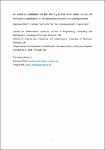An external validation of the Kidney Donor Risk Index in the UK transplant population in the presence of semi-competing events
| dc.contributor.author | Riley, S | |
| dc.contributor.author | Tam, K | |
| dc.contributor.author | Tse, W-Y | |
| dc.contributor.author | Connor, A | |
| dc.contributor.author | Wei, Y | |
| dc.date.accessioned | 2023-11-06T22:02:51Z | |
| dc.date.available | 2023-11-06T22:02:51Z | |
| dc.date.issued | 2023-11-21 | |
| dc.identifier.issn | 2397-7523 | |
| dc.identifier.issn | 2397-7523 | |
| dc.identifier.other | 20 | |
| dc.identifier.uri | https://pearl.plymouth.ac.uk/handle/10026.1/21595 | |
| dc.description.abstract |
Background Transplantation represents the optimal treatment for many patients with end-stage kidney disease. When a donor kidney is available to a waitlisted patient, clinicians responsible for the care of the potential recipient must make the decision to accept or decline the offer based upon complex and variable information about the donor, the recipient and the transplant process. A clinical prediction model may be able to support clinicians in their decision-making. The Kidney Donor Risk Index (KDRI) was developed in the United States to predict graft failure following kidney transplantation. The survival process following transplantation consists of semi-competing events where death precludes graft failure, but not vice-versa. Methods We externally validated the KDRI in the UK kidney transplant population and assessed whether validation under a semi-competing risks framework impacted predictive performance. Additionally, we explored whether the KDRI requires updating. We included 20,035 adult recipients of first, deceased donor, single, kidney-only transplants between January 1, 2004, and December 31, 2018, collected by the UK Transplant Registry and held by NHS Blood and Transplant. The outcomes of interest were 1- and 5-year graft failure following transplantation. In light of the semi-competing events, recipient death was handled in two ways: censoring patients at the time of death and modelling death as a competing event. Cox proportional hazard models were used to validate the KDRI when censoring graft failure by death, and cause-specific Cox models were used to account for death as a competing event. Results The KDRI underestimated event probabilities for those at higher risk of graft failure. For 5-year graft failure, discrimination was poorer in the semi-competing risks model (0.625, 95% CI 0.611 to 0.640;0.611, 95% CI 0.597 to 0.625), but predictions were more accurate (Brier score 0.117, 95% CI 0.112 to 0.121; 0.114, 95% CI 0.109 to 0.118). Calibration plots were similar regardless of whether the death was modelled as a competing event or not. Updating the KDRI worsened calibration, but marginally improved discrimination. Conclusions Predictive performance for 1-year graft failure was similar between death-censored and competing event graft failure, but differences appeared when predicting 5-year graft failure. The updated index did not have superior performance and we conclude that updating the KDRI in the present form is not required. | |
| dc.format.extent | 20- | |
| dc.format.medium | Electronic | |
| dc.language | en | |
| dc.publisher | BioMed Central | |
| dc.subject | Survival analysis | |
| dc.subject | Time-to-event model | |
| dc.subject | Competing events | |
| dc.subject | Risk prediction | |
| dc.subject | External validation | |
| dc.subject | Kidney transplantation | |
| dc.title | An external validation of the Kidney Donor Risk Index in the UK transplant population in the presence of semi-competing events | |
| dc.type | journal-article | |
| dc.type | Article | |
| plymouth.author-url | https://www.ncbi.nlm.nih.gov/pubmed/37986130 | |
| plymouth.issue | 1 | |
| plymouth.volume | 7 | |
| plymouth.publisher-url | http://dx.doi.org/10.1186/s41512-023-00159-9 | |
| plymouth.publication-status | Published online | |
| plymouth.journal | Diagnostic and Prognostic Research | |
| dc.identifier.doi | 10.1186/s41512-023-00159-9 | |
| plymouth.organisational-group | |Plymouth | |
| plymouth.organisational-group | |Plymouth|Faculty of Science and Engineering | |
| plymouth.organisational-group | |Plymouth|Faculty of Science and Engineering|School of Engineering, Computing and Mathematics | |
| plymouth.organisational-group | |Plymouth|REF 2021 Researchers by UoA | |
| plymouth.organisational-group | |Plymouth|Users by role | |
| plymouth.organisational-group | |Plymouth|Users by role|Academics | |
| plymouth.organisational-group | |Plymouth|REF 2021 Researchers by UoA|UoA10 Mathematical Sciences | |
| plymouth.organisational-group | |Plymouth|REF 2021 Researchers by UoA|ZZZ Extended UoA 10 - Mathematical Sciences | |
| plymouth.organisational-group | |Plymouth|Users by role|Researchers in ResearchFish submission | |
| dc.publisher.place | England | |
| dcterms.dateAccepted | 2023-09-11 | |
| dc.date.updated | 2023-11-06T22:02:51Z | |
| dc.rights.embargodate | 2023-11-28 | |
| dc.identifier.eissn | 2397-7523 | |
| rioxxterms.versionofrecord | 10.1186/s41512-023-00159-9 |


